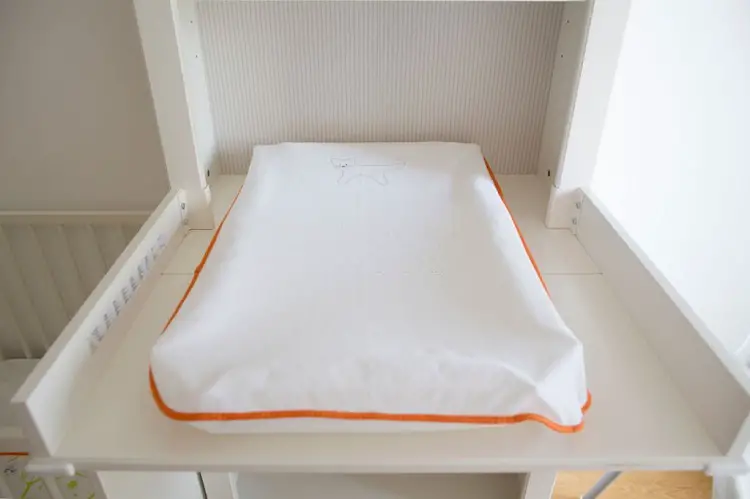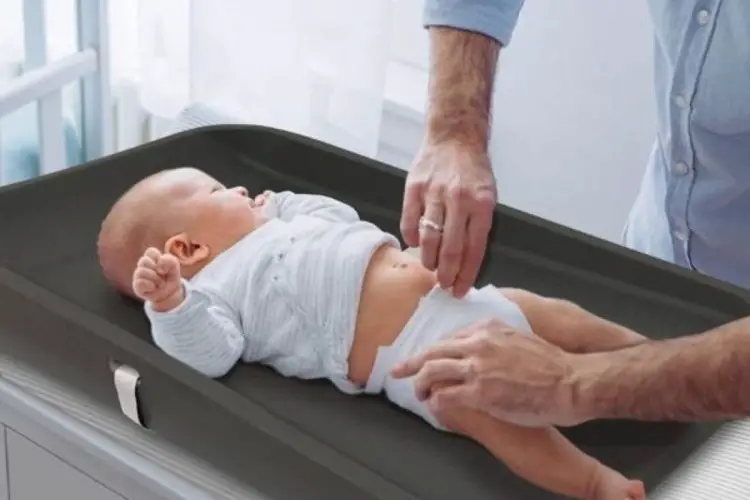Most parents want to secure a changing pad to a dresser in their baby’s nursery to save space.
When the top of a dresser is converted to a changing table, it saves a lot of space and also allows one have storage and a clean surface in one piece of furniture.
Having parents buy into the idea of converting their dresser into a changing table isn’t an issue, but most parents would want to know how to secure changing pad to dresser.
Your question will be answered when you ride with me in this article, and hopefully, by the time you’re done reading, you will have the techniques of how to secure changing pad to dresser at your fingertips.
Changing Table: All You Need To Know
When you talk about a changing table, the simplest definition is a table with a flat surface whose primary use is for changing a baby’s diapers, clothes, and other stuff.
Having a changing table in your home isn’t a must, but its presence makes diaper and clothes changing a lot easier for you as a nursing mum as you can do them comfortably.
If you are contemplating saving space, you can secure your changing pad to your baby’s dresser.
Things To Consider Before Securing Changing Pad To Dresser
Before securing your changing pad to a dresser, there are things you have to consider and check out first before you begin securing your changing pad to a dresser.
Some of the things you need to consider before securing your changing pad to dresser include:
1. Check your dresser: the height and top
The choice you make for a dresser is determined by your preferences and what goes for you, but it is also advisable that what you buy should be at least close to the descriptions of experts.
Ideally, the height of a dresser should not exceed 33 to 41 inches, and when choosing a dressing table, you are encouraged to choose one within this range.
When you want to secure a changing pad to a dresser, you need to ensure that the top of your dresser is wide enough to accommodate a changing pad so that your little one is not at risk.
2. Finding a changing pad that fits
Having assured yourself that the number one assignment has been done effectively, you move to the second stage of buying a changing pad that fits on the top of your dresser in its entirety.
In most cases, experts recommend purchasing a vinyl-implicated pad as this product has all it takes to ensure your baby’s safety.
When buying a pad, buy one that has restraint straps instead of one that lacks restrainable straps, as the one with restraint strap will hold your baby in place effectively.
How To Secure Changing Pad To Dresser

Thinking of how to secure changing pad to a dresser, the following tips will put you at ease and help you secure your changing pad to a dresser.
Use Velcro
Velcro is a simple but effective way of securing your changing pad to a dresser and is very specific.
Velcro has a couple of strip materials, and on one of the strips, there are lots of tiny hooks, while millions of thinner loops are available on the second strip.
When these strips are pressed together, the hooks cling to the loops to keep you from slipping while changing diapers.
To ensure that your child is not jeopardized, please use large-scale Velcro as it will give a perfect job. Here is how to secure changing pad to dresser.
- Separate the pieces and attach them to one side of each of the four corners of the top of your dresser.
- On the other sides of the four corners of the changing pad, paste the remaining sides.
- Install the sides so that the Velcro sticks together, and your changing pad will be held on top of the dresser.
Use Straps
If you are observant enough, you will notice that most traditional changing tables usually have straps.
Such attachment is needed to secure your baby and prevent falling during a diaper change. You can utilize those straps in securing a changing pad to a dresser.
I like the Kolpak Changing Station Straps you can buy get on Amazon. Alternatively, you can also buy any other type of straps at any nearby baby stores; so far, they suit to serve the purpose. Here is how to secure changing pad to dresser.
- Screw one end of your baby’s changing pad buckles into the front and the other into the back of the dresser.
- Pull the straps up and place them flat on the dresser’s top.
- Put the changing pad on top and cross the straps up and over
- Buckle them at the center.
Use Non-Skid Mats
A non-skid mat is usually used to prevent rugs from slipping on hard floors and can also be used to stick a changing pad to a dresser. Here is how to secure changing pad to dresser.
- Cut the non-skid mat so that it fits the dresser and changing pad.
- Attach the mat to the dresser’s top
- Stick the changing pad to the top of the non-skid mat
- Ensure that the changing pad is not knocked or pulled off.
Use Screwed Snap Button
This method is ideal for changing pads that come with pre-attached safety straps. The best part about this technique is that it does not permanently place the pad.
As a result, you’ll be able to attach and detach the changing pad whenever you want. Here is how to secure changing pad to dresser.
- You must first attach the snap button to the straps. Make a small hole in each strap and insert one part of the button.
- Using a drill machine, attach the screwed portion of the snap buttons to the upper part of the dresser. By positioning the buttons together, you can ensure they can be easily connected to the straps.
- Finally, place a non-skid mat beneath the changing pad to keep it from moving while changing the diaper.
Invest in Sticky Changing Pads
Some kinds of changing pads are sticky at the bottom. This feature makes the job easier for you to anchor the pad to your dresser. If you have a changing pad that is sticky at the bottom, you can utilize that. Here is how to secure changing pad to dresser.
- To do this, remove the plastic coating underneath, from which the adhesive part can be exposed.
- Gently press the bottom of the changing pad to the top of the dresser.
Always be vigilant to notice when the changing pad starts to move. This is because this sticky pad can become loosened and may result in an accident.
Safety tips
Securing your changing pad to the dresser to form a changing table is quite a smart idea, but it could become a disaster if you don’t comply with some safety guidelines.
As a concerned parent, you won’t want your baby or you to be greatly affected due to some carelessness during the installation.
With this in mind, you must follow the safety tips below to avoid putting your baby’s life in danger.
- Go for diaper changing pads that have two different types of straps. We suggest you choose an adjustable restraint belt with a buckle as it offers the best protection for your baby.
- Use a changing pad with a waterproof surface that can easily be wiped clean, as absorbent pads can lead to mold accumulation. For maximum protection, use reusable waterproof pads that are soft, have a cozy feel, and can be easily put in washers and dryers.
- When using Velcro, use the scale Velcro so that you can assure the safety of your child.
Read Also: How To Repurpose the Baby Changing Table (17 Creative Ideas)
Frequently Asked Questions
Do I need a changing pad cover?
No, covers and liners are nice, but they aren’t required. The covers and liners serve a different function than the pad.
The pad is designed to cushion your baby during diaper changes and protect surfaces from pee and poop that leaks from the diaper.
What is the use of straps on a baby changing pad?
The changing pad’s security straps keep it tightly fastened to furniture, and the non-skid bottom ensures it won’t slip or move. The soft, warm foam is soothing for babies, and the durable quilted double-layer vinyl is easy to clean for parents, caregivers, and anyone who comes into contact with the baby.
Are all changing pads the same size?
The standard size is approximately 17′′32′′, but it can be an inch or two larger or smaller on either side or both sides.
Fitted changing pad covers typically have elastic around them and plenty of room to accommodate anything larger or smaller. As a result, anything around this size will suffice.
Wind Up
I am sure that the answers to the question on how to secure a changing pad to dresser.
Integrating a changing pad and a dresser into one piece of furniture is awesome, and if the instructions are followed, you will achieve your heart’s desires seamlessly.
While going about the securing activity, pay attention to the safety tips so that you don’t put yourself at risk.
